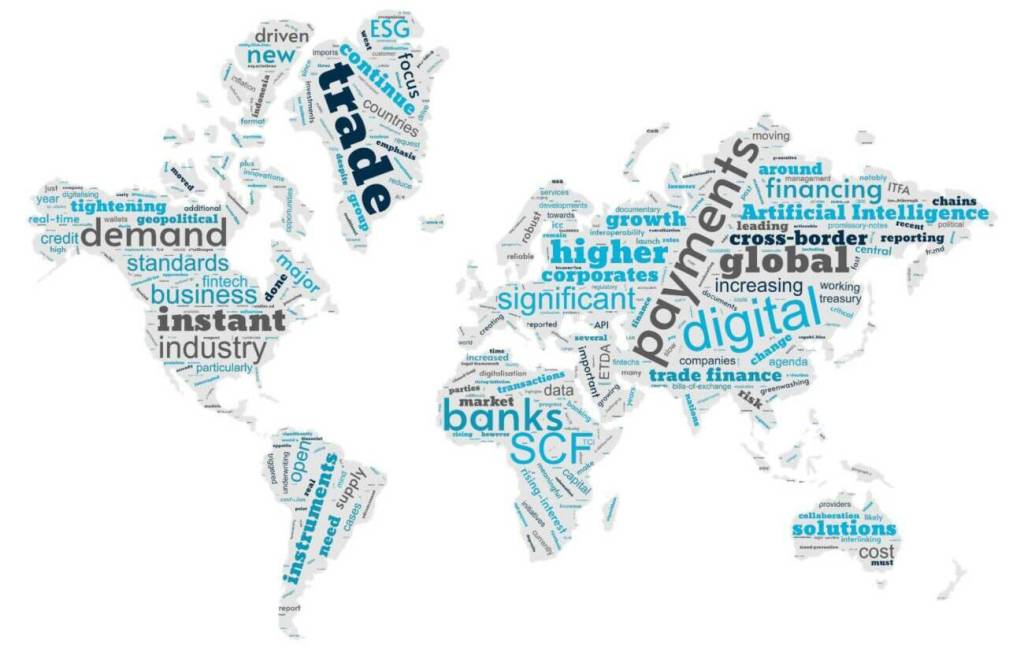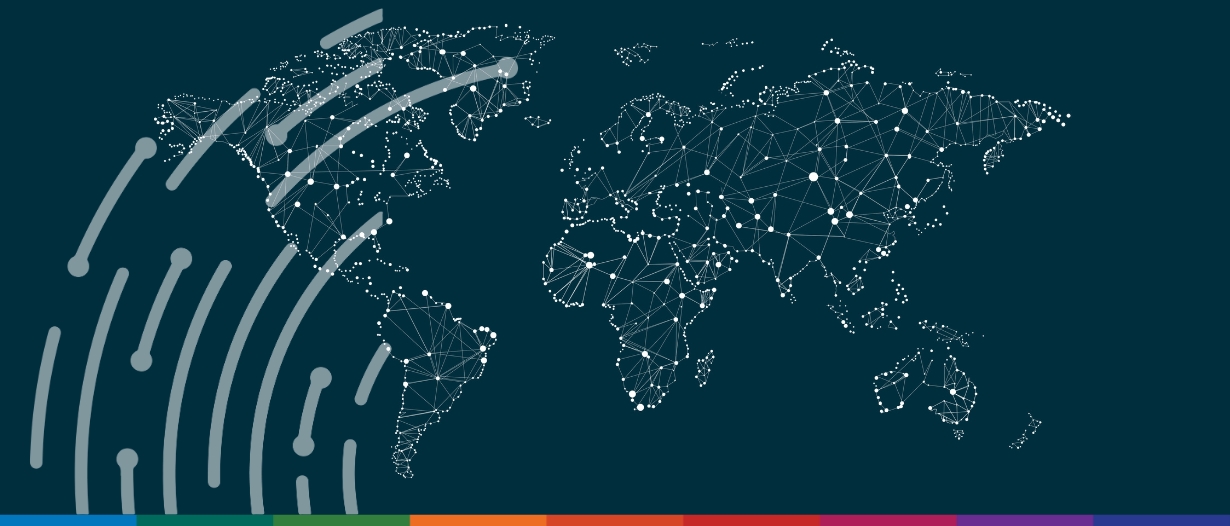Estimated reading time: 8 minutes
As we begin to look ahead to the new year, many of us find value in taking a pause to look back and reflect on the past 365 days.
At TFG, we took the time to reflect back on the happenings across trade, treasury, and payments in 2023. After sifting through our news archives and speaking with industry experts, we devised this list of 9 key events and themes that shaped trade, treasury, and payments in 2023.

1. Generative AI goes mainstream
According to the Chinese Zodiac, 2023 might be the Year of the Rabbit, but it will be remembered as the year of Generative AI.
The powerful new technology has undoubtedly swept the headlines this year, with users applying its powers to increasingly more innovative use cases as the year went on.
For trade, treasury, and payments, the technology seems poised to usher in an era of improved efficiency, better risk assessments, and enhanced customer experiences, but the extent of the use case is still yet to be fully realised.
Darren Parslow, Global Head of Visa Commercial Solutions, said, “Having been commercialised for barely a year, the industry is still figuring out the multitude of applications of generative AI across the commercial payments ecosystem.”
For their part, many trade credit insurers also turned towards AI to enhance their underwriting processes and risk assessment capabilities with more substantial use of AI tools across all business and geographic boundaries.
2. Major trade platforms collapse
While AI was on the rise in 2023, several other major technology-driven trade platforms experienced a decline.
In February, the Marco Polo Network – a blockchain-based platform aiming to streamline and simplify global trade finance processes – shuttered its doors. In October, Contour – another digital trade finance platform – closed down as well, citing insufficient funding from its bank shareholders.
These follow closely on the heels of the 2022 collapses of the we.trade network (June 2022) and TradeLens (November).
While these may seem like a significant blow to the notion of platformed trade finance, for some, they merely represent welcomed lessons learned for the future of trade digitalisation.
Enno-Burghard Weitzel, SVP of Strategy, Digitisation, and Business Development at Surecomp, said, “2023 saw the end of closed-loop digital island propositions circling around technology. It’s never about the technology but about solving a meaningful problem with a reliable solution.”
On the topic of partnerships, a positive spin on platforms was the number of collaborations between tech-banks (e.g. J.P. Morgan and ClearEye) and tech-tech. Mariya George, CEO & Co-Founder, ClearEye, said, “This collaboration is mutually beneficial, aiding both parties in scaling up. Financial institutions benefit by offering innovative products and streamlining their outdated manual processes, while fintechs gain the necessary support to expand and reach more markets.”
3. Transition to ISO 20022
The migration to ISO 20022, which began in March, has been a pivotal move for financial institutions, significantly enhancing data quality and transaction efficiency.
ISO 20022 is a global standard for electronic data interchange between financial institutions that provides a framework for creating financial messages using a standard approach. It covers various types of financial transactions, including payments, securities trading and settlement, foreign exchange, and credit and debit card transactions.
Barry Rodrigues, EVP of Payments at Finastra, said, “2023 was a major milestone in the payments industry as financial institutions across the world migrated to the ISO 20022 messaging standard.”
This transition facilitates global interoperability and is playing a key role in meeting regulatory standards, while also preparing systems for future financial technologies.
4. COP28 and the ESG agenda
The past year has also brought a reinvigorated, though not always aligned, interest in environmental, social, and governance (ESG) considerations.
While there has been a growing focus on incorporating ESG in trade finance, there has also been confusion and a lack of clarity on what ESG entails for the industry, particularly regarding reporting and implementation standards.
Johanna Wissing, Board Member, ITFA ESG Committee, said, “2023 was highlighted with rapid regulatory developments from a sustainability perspective, which has led to high-level confusion, especially on what data to record and what to report from an audit perspective.”
The challenges associated with such rapid regulatory changes in ESG reporting have helped to enhance efforts in 2023 towards harmonising standards and establishing common frameworks for ESG assessment in trade.
Efforts are well underway from organisations like the ICC, BAFT, and ITFA to create standards for ESG reporting in trade and supply chain finance, but there is still much more left to be done.
The year culminated with the COP28 summit in Dubai with more uncertainty and mixed emotions. Some hailed the conference as a landmark win, with its Consensus formally calling on all parties to transition away from fossil fuels. Others are disappointed by what they see as more loophole-ridden empty promises devoid of real action.

5. Trade volumes fluctuating
The past twelve months have been marked by fluctuating trade volumes and demand for trade financing.
Early in 2023, many countries reported significant demand growth for receivables and supply chain finance, partly due to high demand for fast-moving goods such as food commodities coupled with rising inflation.
As the year progressed, high interest rates and inflation made trade finance more expensive and added another commercial burden to trade. The higher prices have made trade less attractive for many parties, affecting the demand for traded goods and leading to reduced trade flows as the year has progressed.
Despite the challenges, however, the industry has remained resilient overall, a promising sign going into the new year.
6. Adoption of ETDA
While digitalisation generally was widespread throughout 2023, there was perhaps one highlight in trade that stands above the rest in terms of signifying a new digital era ahead: the official enactment of the UK’s Electronic Trade Documents Act (ETDA).
This legislation indicates a significant shift towards legal recognition of digital trade documents and provides the legal backing necessary for the widespread adoption of digital instruments in trade finance.
The Act, first introduced into Parliament as a Bill in October 2022, received Royal Assent and officially became an Act of English Law in July this year, in a much anticipated and welcomed transition to a new era for digital trade.
Andre Casterman, Founder of Casterman Advisory, said, “The ETDA serves as proof that lawmakers and technologists are aligned and can deliver change together.”
7. New and lingering conflicts
While it has been a year of progress in many respects, 2023 has also been a year of continued violence and suffering for many.
Russia’s war in Ukraine continues to linger, and the global humanitarian crises have been compounded by the conflict erupting in the Middle East in October.
For trade, these events, coupled with rising tensions between major economic powerhouses like the US and China, have reshaped global trade dynamics, increased political risk considerations, and affected international trade strategies.
Alexia Boutin-Somnolet, LSG Leader Europe at Marsh, said, “Conflict in several regions coupled with rising tension between the global west and autocratic regimes in other parts of the world continue to drive a focus on robust and shorter supply chains, reducing opportunities for trade.”
8. Red Sea shipping challenges: Fallout from the Middle Eastern turmoil
As the year comes to a close, an influx of attacks from Yemen-based and Iranian-backed rebels on vessels carrying goods through the Red Sea has forced many of the major global shipping firms to avoid the critical sea route that guards access to the Suez Canal.
They have opted instead for alternative routes, notably around the Cape of Good Hope in South Africa, which adds significant travel time and cost to trade between Europe, Asia, and the Middle East.
This disruption brings back echoes of the March 2021 Suez Crisis, where the canal was blocked for six days by the Ever Given, a container ship that had run aground, causing considerable shipping disruptions in the process.
Some experts predict that this latest Red Sea disruption could cause shipping prices to double, owing to the direct costs of travelling longer distances coupled with the constrained shipping capacity that longer times at sea will cause.
9. Credit insurance demand increases
Partially stemming from the widespread economic and geopolitical instability, 2023 has brought a heightened demand for trade credit insurance.
Richard Wulff, the executive director at ICISA, said, “The year 2023 brought instability to markets, both economically and geo-politically. The rise of inflation, the first time in a generation, and the related increase in interest rates have put an end to the era of free money. This was reflected in increasing instances of insolvency and therefore brought loss ratios back to relatively normal levels.”
This insurance is a form of protection against the risk of non-payment by a customer and has become increasingly popular as the global economy becomes increasingly interconnected and complex. As country risks and the cost of shipping increase, so does the need for credit insurance as companies look to protect themselves from potential losses.
While the demand for trade credit insurance has increased, the trade credit insurance industry, in general, has taken a conservative approach to underwriting in 2023. While global economic uncertainty and rising country risk may be to blame, it is traders who will be forced to bear the increased costs of conducting business abroad – if they continue at all.
The combination of increased demand and reduced supply of trade credit insurance cover has contributed to the rising trade costs in 2023, with some experts believing that trade credit insurers are leaving significant opportunities on the table.
The key events from 2023 in the realms of trade finance, international trade, and related sectors revolve around navigating through economic and geopolitical challenges, embracing digital transformation, and integrating ESG considerations into trade practices.
Many of these significant events and their ensuing implications have been deeply intertwined, with some relying on others to occur before they could themselves come to fruition.
This complex interplay that we reflect on as 2023 draws to a close will undoubtedly greet the industry as we begin to traverse the new year and learn about what 2024 has in store.























